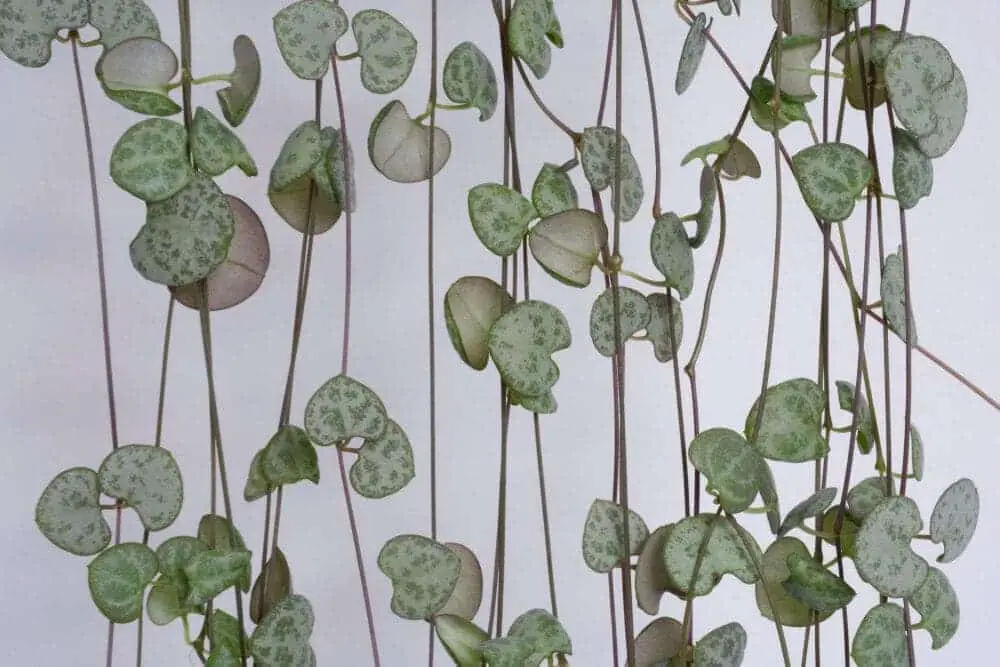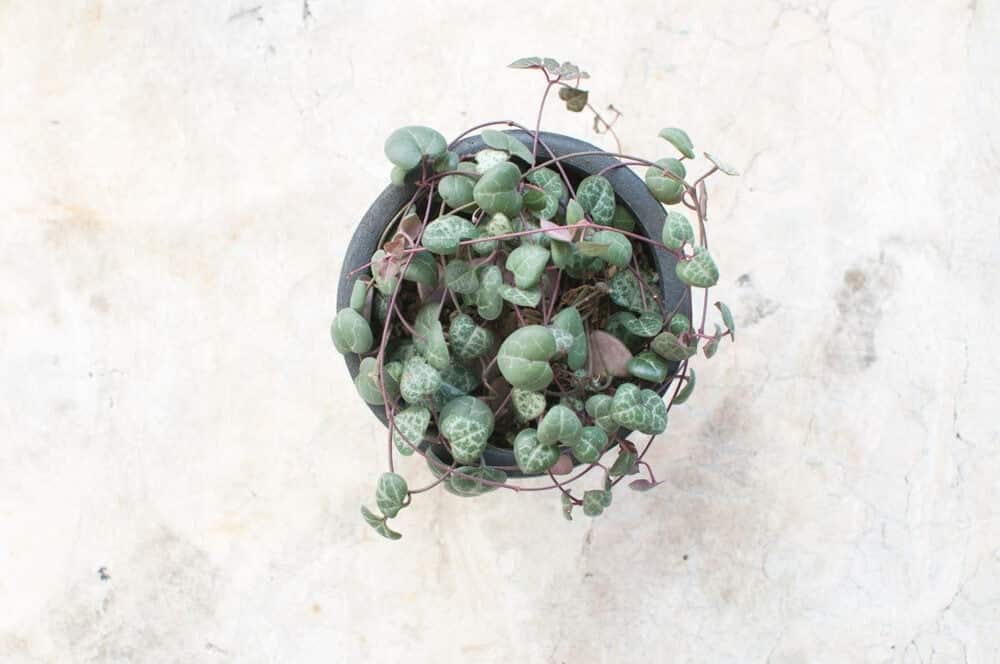The String of Hearts plant, or Ceropegia woodii, is quite a striking plant that is perfect for any home.
It is a very adaptable and tough plant that just about anyone can grow and care for with ease. In this article, you will learn everything you need to know about them.
String of Hearts Care & Growing Guide
1. Light Requirement
This plant requires bright but indirect sunlight. Too much bright light can damage this plant beyond saving. If the leaves on the tree appear light and very far apart, you most likely need to increase its light exposure.
You cannot keep one of these plants in a low light area, as it will quickly wither away and die. If you keep it inside, make sure that it is about three feet from a window that faces east, west or south.
2. Water
Make sure that you wait until the soil has completely dried out before watering it. You don’t need to water these plants much in the winter months. Watering this plant too often will cause root rot, which means imminent death.
3. Climate
These plants can be grown in a USDA hardiness zone 10 outdoors. These plants prefer a sunny and warm climate.
4. Soil
You should use a succulent cactus mix for this plant. It is very important that you use a well-draining soil so that the plant doesn’t develop root rot from excess moisture.

5. Temperature
A temperature range of 80 to 85 degrees Fahrenheit is best for these plants. They like lots of bright, warm sunlight in the afternoon. You will want to bring this plant inside if it gets any colder than 60 degrees Fahrenheit outside. These plants don’t do very well when exposed to even mildly cold temperatures for short periods.
6. Repotting
You’ll want to ideally hold out until spring or summer to repot your String of Hearts plant. You can also do this in autumn if you are in a temperate climate. It is never a good idea to do this during the winter, as it is your plant’s resting period.
It is also important that you move the plant to a container that is a couple of inches larger than its previous home. Be careful when you are removing it from the pot, as the roots can get tangled and break off.
7. Speed of Growth
Keep in mind that these plants do grow fairly quickly, especially when they are given ample indirect sunlight on a daily basis.
8. Height and Spread
These plants can grow up to 12 feet long with a spread of about four or five feet. It is a good idea to leave a minimum of six feet between plants to avoid root problems.
9. Flowers
You can expect this plant to bloom in the summer and autumn months each year. This plant can produce flowers at seemingly strange times. Each flower is about an inch long with a bulky base with a pale magenta coloration that is quite spectacular.
10. Trimming
You will have to occasionally trim this plant as it grows to maintain the shape and size you want. You shouldn’t have to do a lot of pruning, but it will be occasionally required. It’s also important that you trim off all of the dead leaves with brown or yellow spots on them.

Can String of Hearts Plants Grow in Water?
You can in fact grow a String of Hearts plant in water. You will start by placing the cuttings in a vase filled with water. It shouldn’t take very long before you start seeing visible progress.
How to get String of Hearts Plants to Flower
If you want to get your String of Hearts plant to flower, it is important that you provide it with lots of bright, indirect sunlight. Adequate light is definitely one of the most important factors when it comes to this plant blooming.
A high-nitrogen fertilizer and some compost on the top layer of the soil can also encourage flowering. Keep in mind that it is far more difficult to get these plants to flower when you keep them indoors.
Common String of Hearts Plant Diseases
Root rot is a fairly common problem with these plants that you will need to make a point of avoiding altogether. You can keep this from happening by simply watering your plant when it is appropriate. Over watering can quickly kill these plants, so you need to keep that in mind.
Aphids can also become an issue with a String of Hearts plant. Make sure that you keep a close eye on your plant and check for these pests regularly. It doesn’t take long for them to destroy a perfectly healthy plant.
If you find that you are having problems with pests of any kind on your plant, you should invest in a good repellent. There are lots of these products on the market, so you’ll want to spend some time looking over your options. Just spray the repellent on the plant’s foliage each day. This should be fairly effective at keeping aphids and other pests away.
Conclusion
- The String of Hearts plant needs lots of bright but indirect sunlight during the afternoon.
- If you keep this plant indoors, you’ll want to keep it a few feet from a western, eastern, or southern-facing window.
- Make sure that the soil is completely dry before watering this plant. Watering it when the soil is still moist can lead to root rot.
- A temperature range of 80 to 85 degrees Fahrenheit is best for these plants.
- These plants tend to do best when they are kept in a dry, warm climate with plenty of bright sun.
- You can expect this plant to grow up to 12 feet tall by about four to five feet wide.
- The best way to get these plants to flower is to provide them with plenty of bright sunlight. You can also try using a high-nitrogen fertilizer.
- Pests like aphids can become a problem with these plants, so keep an eye out for them each day.

Victoria is the owner and main author of hobby plants. She loves spending her free time in her garden planting and taking care of her plants. Victoria hopes you enjoy the content here!